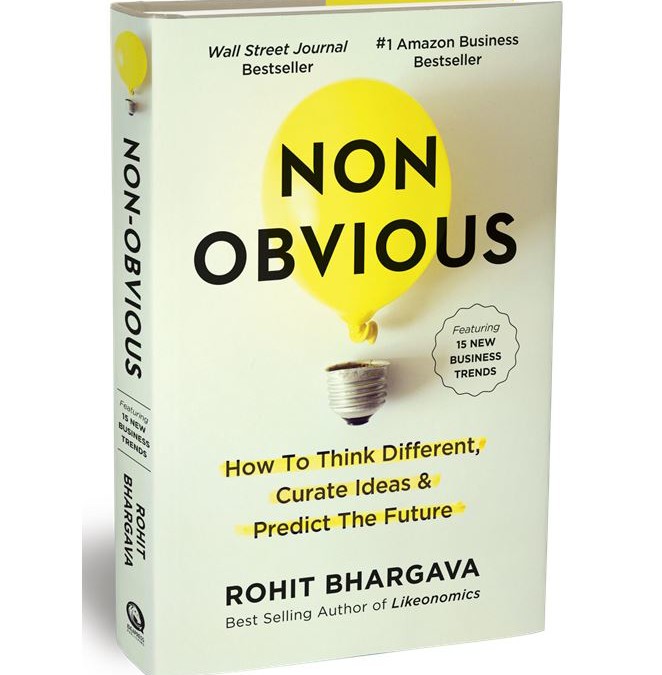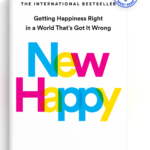Rohit Bhargava is one of those individuals who is a curator, a synthesizer and a grand observer.
He teaches marketing at Georgetown University and for the last several years has published his non-obvious trends by trying to understand what others who try to predict the future miss. Large corporations have used his approach to help them see ahead of their competition with a peak into tomorrow.
In his latest book that was just published called Non-Obvious, he brings together observations as disparate as why comedy clubs may start charging by the laugh or why mindfulness is seeping its way in the corporate C suite. More than the trends alone, the book is ripe with insight into his process and he provides details how he does his trend curation. His methodology brings a practical aspect to a book filled with intriguing ideas.
He also looks back at his own predictions and trends and gives an honest review of his hits and misses and why. Rohit’s approach is refreshing. He helps you see how sometimes a picture isn’t as clear when you are too close and you miss the connecting dots. One method is suggests is that he keeps a physical copy of things that grab his attention. It could be a quote from a speaker at a conference or an article in an obscure magazine or an Instagram image. He takes these printed pages and goes back to them to see if there is a link or connection that becomes more obvious when he has all of this in front of him sitting on a table.
He offers a free download of the 15 trends, which I am reprinting here. These are all his ideas. I’d urge you to get a copy of this book so that you can begin to think about the many ways this approach could be helpful to new markets, new approaches or new directions that you may be thinking about for your brand or business.
Consider how one of these trends might impact your own business in the near term.
The 2015 Non-Obvious Trends Report
The Reluctant Marketer – Why brands are focusing less on traditional marketing and promotion and more on content marketing and customer experience.
Glanceable Content – How companies are leveraging our shrinking attention span to create content designed for rapid consumption.
Mood Matching – How the proliferation of sophisticated media, advertising and immersive experiences can be tailored to match consumer needs like never before.
Everyday Stardom – Learn how the growth of personalization leads more consumers to expect everyday interactions to be transformed to celebrity-type experiences.
Selfie Confidence – Why the ability to share a carefully crafted online personality allows people to use social content such as selfies (yes selfies) as a way to build their own confidence.
Mainstream Mindfulness – Mediation, yoga and quiet contemplation become powerful tools for individuals and organizations to improve performance, health, and motivation.
Branded Benevolence – Companies increasingly put brand purpose at the center of their businesses to show a deeper commitment to doing good as a part of business.
Reverse Retail – Brands invest in high-touch in-store experiences as a way to build brand affinity and educate customers, while driving actual purchases online through ecommerce.
Experimedia – Content creators use social experiments and real life interactions to study human behavior in unique new ways and build more realistic and entertaining narratives.
Unperfection – As consumers seek out more personal and human experiences, brands and creators use personality, quirkiness and intentional imperfections to be more desirable.
Predictive Protection – The combination of high privacy concerns with tech advances lead to more intuitive products, services and features to help us live our lives better and more safely.
Engineered Addiction – A greater understanding of habit formation leads to more designers & engineers intentionally create addictive experiences to capture time and attention.
Small Data – As consumers increasingly collect their own data, brand-owned big data becomes less valuable than immediately actionable small data owned by consumers themselves.
Disruptive Distribution – Creators and makers use new models for distribution to disrupt the usual channels, cut out middlemen and build more direct connections with fans and buyers.
Microconsumption – Why pioneering new ways to consume and pay for content are leading to a revolution in new business models for startups and brands.
Three Trends That Struck Me
His ideas on glanceable content really intrigues me. It aligns with my own thinking I call ‘snack-sized information’ that is munchable. Glanceable content is seen through social media but it many places in the workplace where large reports are now reduced down to simple executive summaries. Consumers need short headlines and quick pieces of information that get straight to the point. Companies like the Skimm, have taken advantage of this. They give you the 2 minute read about the news – when you don’t have 30 minutes or an hour to read a newspaper, magazine or watch cable.
Another trend, disruptive distribution is also a fascinating observation as producers (creators) need new ways to get products to market in surprise locations. I wrote about this just two weeks ago when I observe a frozen jam at Whole Foods.
Unperfection is another non-obvious trend that points to this idea that we want to get products to market quickly and then fix and revise it on the fly. It sees some humanity in a not quite perfect blog that has mistakes or minor errors. Quirkiness becomes the antidote to the type A/100%/perfect approach to the world. Relax, its close enough.
My prediction: You’ll buy a copy of Non-Obvious on Amazon. But Rohit offers a free 82 page excerpt from the book on his website. I think I smell another trend.
Interested in growing your business? I can help you increase profitable revenue with marketing insights. To learn more, click this link.




